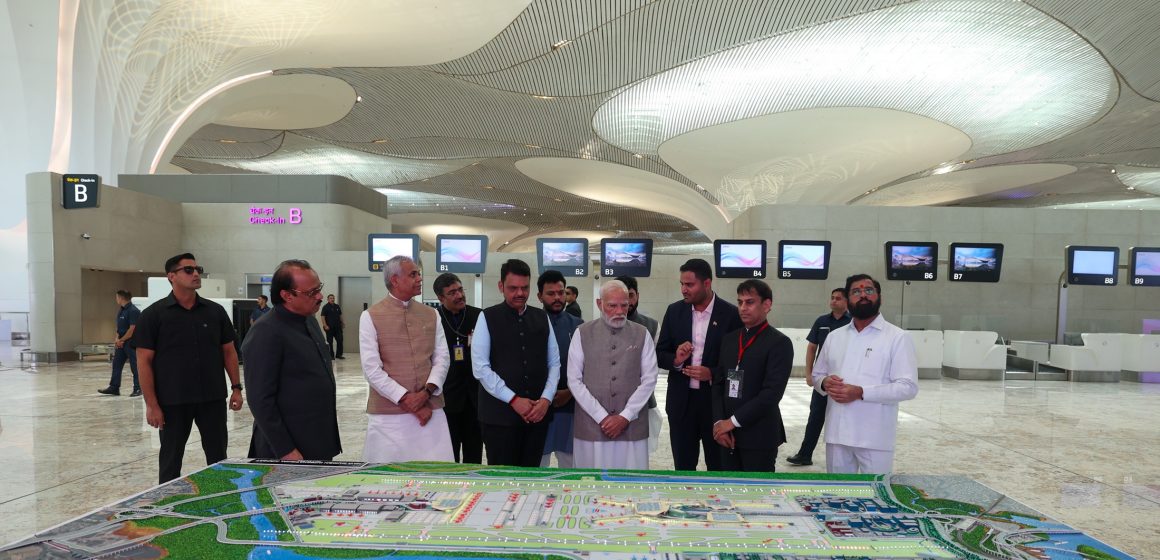The ₹167 billion Navi Mumbai International Airport (NMIA) project is expected to boost Maharashtra’s GDP by 0.5 per cent, catalyse real estate growth, and reposition Mumbai as a global twin-airport city alongside aviation hubs such as Dubai, London and New York.
Putting an end to a long wait spanning nearly two decades, Prime Minister Narendra Modi inaugurated the Navi Mumbai International Airport (NMIA) on Wednesday. The launch of this landmark project provides a vital alternative air connectivity hub to one of India’s most densely populated urban clusters, while marking a defining milestone in the country’s aviation and infrastructure journey.
Speaking at the inauguration, the Prime Minister said, “Mumbai’s long wait is over. This new airport will connect Maharashtra’s farmers directly to global supply chains and reduce logistical costs for small industries. It will attract investment, create new ventures and strengthen India’s position as a global aviation leader.”
The inauguration formed part of a broader set of developmental launches in Mumbai, including the city’s first fully underground metro.
“This remarkable metro has been constructed underground while preserving historic buildings. It is a living symbol of a developing India,” said the Prime Minister, congratulating the engineers and workers involved.
Modi also highlighted the ₹600 billion PM Setu scheme to link Industrial Training Institutes (ITIs) with industry, and Maharashtra’s rollout of new training programmes in emerging technologies such as drones, robotics, electric vehicles, solar energy and green hydrogen.
“India is the youngest country in the world, and its strength lies in its youth,” he said, citing infrastructure investment as a key driver of employment.
The Prime Minister recalled his 2014 vision that even those wearing hawaii chappals—a phrase he uses to describe the common citizen—should be able to travel by air. “In 2014, India had only 74 airports; today, the number has crossed 160,” he said, crediting the UDAN regional connectivity scheme for enabling millions to fly for the first time.
He affirmed that India is now the world’s third-largest domestic aviation market, with airlines placing orders for hundreds of new aircraft and expanding MRO capabilities to meet rising demand.
The ₹167 billion NMIA project is expected to boost Maharashtra’s GDP by 0.5 per cent, fuel real estate growth and reposition Mumbai as a global twin-airport city alongside hubs like Dubai, London and New York. As India advances toward its Viksit Bharat 2047 vision, a mega-airport project like NMIA is positioned as a symbol of collaborative development, sustainable infrastructure and the country’s rising stature in global aviation.
Dawn of Mumbai’s Twin Airport Era
Built on the land of Chhatrapati Shivaji Maharaj and shaped like a lotus flower, NMIA symbolises culture, prosperity and modern engineering. Designed by Zaha Hadid Architects, the terminal architecture blends cultural symbolism with sustainability features such as passive cooling systems and natural light integration.
Developed through a public-private partnership (PPP) between Adani Airport Holdings Ltd (AAHL) and the City and Industrial Development Corporation of Maharashtra Ltd (CIDCO), NMIA is envisioned as Asia’s next connectivity hub. It will operate alongside Chhatrapati Shivaji Maharaj International Airport (CSMIA) as part of a twin-airport system for the Mumbai Metropolitan Region. With an initial capacity of 20 million passengers per annum (MPPA), the airport will scale up to 90 MPPA, supported by four runways, multiple terminals and a dedicated cargo hub.
Gautam Adani, Chairman, Adani Group, called NMIA “a gateway to exponential possibilities,” adding, “Every flight through these terminals will carry not just passengers, but the pulse of a defining superpower.”
“With NMIA, we are uniting cutting-edge technology, sustainability and a passenger-first experience,” added Jeet Adani, Director, Adani Airport Holdings. “By complementing CSMIA, it reinforces Mumbai’s role as a global aviation hub and sets a blueprint for future-ready airports nationwide.”
The airport is integrated with the Mumbai Trans Harbour Link, metro networks, suburban rail and planned waterways, enabling seamless multimodal connectivity. Its proximity to Jawaharlal Nehru Port Trust (JNPT) creates a sea-air logistics corridor, with cargo facilities capable of handling 0.5 million tonnes (MT) annually in the first phase and 3.2 MT at full build-out.
NMIA also introduces a new retail strategy, with over 110 outlets, experiential zones and landside entertainment areas designed to boost non-aeronautical revenue. The airport’s Pharma Excellence Centre and perishable cargo village are expected to support key sectors, including agriculture and life sciences.
-Manish Pant


